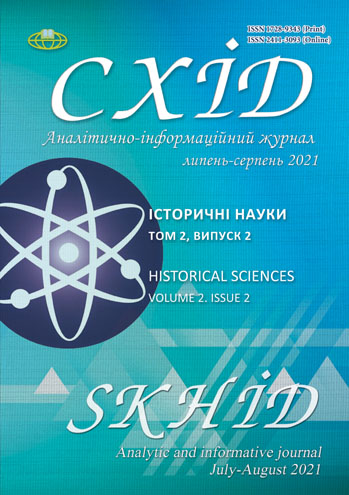THE ROLE OF HISTORICAL AND ARCHAEOLOGICAL MUSEUMS AS SOCIAL INSTITUTIONS IN THE FORMATION AND POPULARIZATION OF HISTORICAL AND CULTURAL MEMORY (ZHOUCOUDIAN MUSEUM, CHINA)
DOI:
https://doi.org/10.21847/1728-9343.2021.2(2(2)).239409Keywords:
historical memory, cultural memory, historical and archeological museum, socio-cultural research, knowledge, values society, ZhoukoudianAbstract
The article analyzes the role of historical and archaeological museums as public institutions in the formation and promotion of historical and cultural memory in modern conditions of constant change: from the functions of museums through technology to public expectations and needs of the audience. The historical and archaeological museum is considered a socio-cultural institution that fulfills the mission of preserving, broadcasting, and interpreting historical and cultural memory. Based on the properties of historical and cultural memory defined by the author, the functions of museums are established, which ensure its preservation, transition, and interpretation. The article analyzes the dependence of the functions of historical and archaeological museums on changes in the field of communications, technological integration, and the post-epidemic crisis. Given that education and culture are the greatest values of mankind, the author considers one of the main tasks of historical and archaeological museums in the education and cultural de-velopment of society based on historical and cultural heritage. And hence the concept of modern historical and archaeological museums is considered in the direction of scientific and socio-cultural centers.
Downloads
References
About the "Peking Man" specimen. (1952). Science Press, Volume 3, № 1-2, 71-72 pp. (In Chinese).
Bozhchenko, O. A. (September 2012). Historical memory as the form of the museum reflection. SPb. GUKI, №3(12), 112-116 pp. (In Russian).
Chinese workers and young people working in science have discovered human skull fossils from Yunnan, China in Zhoukoudian. (October 18, 1967). Guangming Daily, Beijing. (In Chinese).
Fossils of human skulls in Yunnan, China were once again found in Zhoukoudian. (October 21, 1967). Guangming Daily, Beijing, 3 p. (In Chinese).
Huai, Jianhua (June 20, 2017). The exhibition content and form design of the museum – taking the basic display of the Zhoukoudian Ruins Museum as an example. Source of the article: China Cultural Relics Information Network / Original published in: Chinese Cultural Relics News. China Archaeology Net. Retrieved from: http://kaogu.cn/cn/gonggongkaogu-/2017/0620/58593.html. (In Chinese).
Kuchera, S. (1996). The oldest and most ancient history of China. Eastern Literature, RAN, 431p. (In Russian).
Lanpo, Jia (1951). The disappearance of China's Yunren fossils and the loss of the Cenozoic Research Laboratory during the Anti-Japanese Period. Cultural Relic Reference, Volume 2, № 3, 6 – 19 pp. (In Chinese).
Ma, Huzhen (2021). Mission and Life – The International Sympo¬sium on Museums in the Changing Times was held in Xi’an. Business Network-China Business News. Retrieved from: http://news.hsw.cn/system/2021/0620/1336236.shtml. (In Chinese).
Moruo, Guo et al. (1955). The discovery and research of human fossils in China: A special report on the twenty-fifth anni¬versary of the discovery of the first skull in China. Science Press, Beijing, Shanghai, № 1, 104 p. (In Chinese).
Ovchinnikova, Z. A. (2018). The role of museums in the formation, maintenance and transmission of historical and cultural memory. Bulletin of Culture and Arts, №1 (53), 82-89 pp. (In Russian).
Research on Historical Materialism (1973). The Home of "Beijing People". Beijing Review, Volume 16, № 4, pages 13-16 pp. (In Chinese).
Qi, Cheng (June 11, 2021). Technology empowers the Zhoukoudian site 3D digital protection immersive experience exhibition launched. China Economic Net. Retrieved from: http://www.ce.cn/culture/gd/202106/11/t20210611_36636255.shtml (In Chinese).
The 2019 World Antiquity and Medieval History Teaching and Research Section of the School of History went to Zhoukoudian Peking Man Site and Cross Temple for summer practice. (July 12, 2021). School of History, Beijing Normal University. http://history.bnu.edu .cn/xwdt/237037.html. Retrieved from: (In Chinese).
Zhoukoudian Museum. Retrieved from: https://www.zkd.cn/. (In Chinese).
Downloads
Published
How to Cite
Issue
Section
License
Copyright (c) 2021 ЛІЗА МАРКІНА

This work is licensed under a Creative Commons Attribution-NonCommercial-NoDerivatives 4.0 International License.
1. Authors bear responsibility for the accuracy of facts, quotations, numbers and names used.
2. Manuscripts are not sent back.
3. The publisher does not always agree with the authors' opinion.
4. The authors reserve the right to authorship of the work and pass the first publication right of this work to the journal under the terms of a Creative Commons Attribution-NonCommercial-NoDerivatives 4.0 International License. This license allows others to distribute (copy) the published work for non-commercial purposes, provided there is mandatory attribution to its authors and a link to the first publication in our journal.
5. The authors have the right to conclude separate supplement agreements that relate to non-exclusive work distribution in the form in which it has been published by the journal (for example, to upload the work to the online storage of the journal or publish it as part of a monograph), provided that the reference to the first publication of the work in this journal is included.

